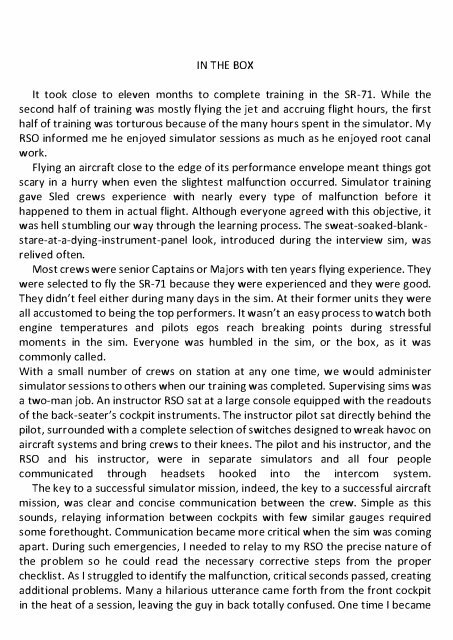Create successful ePaper yourself
Turn your PDF publications into a flip-book with our unique Google optimized e-Paper software.
IN THE BOX<br />
It took close to eleven months to complete training in the SR-71. While the<br />
second half of training was mostly flying the jet and accruing flight hours, the first<br />
half of training was torturous because of the many hours spent in the simulator. My<br />
RSO informed me he enjoyed simulator sessions as much as he enjoyed root canal<br />
work.<br />
Flying an aircraft close to the edge of its performance envelope meant things got<br />
scary in a hurry when even the slightest malfunction occurred. Simulator training<br />
gave <strong>Sled</strong> crews experience with nearly every type of malfunction before it<br />
happened to them in actual flight. Although everyone agreed with this objective, it<br />
was hell stumbling our way through the learning process. The sweat-soaked-blankstare-at-a-dying-instrument-panel<br />
look, introduced during the interview sim, was<br />
relived often.<br />
Most crews were senior Captains or Majors with ten years flying experience. They<br />
were selected to fly the SR-71 because they were experienced and they were good.<br />
They didn't feel either during many days in the sim. At their former units they were<br />
all accustomed to being the top performers. It wasn't an easy process to watch both<br />
engine temperatures and pilots egos reach breaking points during stressful<br />
moments in the sim. Everyone was humbled in the sim, or the box, as it was<br />
commonly called.<br />
With a small number of crews on station at any one time, we would administer<br />
simulator sessions to others when our training was completed. Supervising sims was<br />
a two-man job. An instructor RSO sat at a large console equipped with the readouts<br />
of the back-seater's cockpit instruments. The instructor pilot sat directly behind the<br />
pilot, surrounded with a complete selection of switches designed to wreak havoc on<br />
aircraft systems and bring crews to their knees. The pilot and his instructor, and the<br />
RSO and his instructor, were in separate simulators and all four people<br />
communicated through headsets hooked into the intercom system.<br />
The key to a successful simulator mission, indeed, the key to a successful aircraft<br />
mission, was clear and concise communication between the crew. Simple as this<br />
sounds, relaying information between cockpits with few similar gauges required<br />
some forethought. Communication became more critical when the sim was coming<br />
apart. During such emergencies, I needed to relay to my RSO the precise nature of<br />
the problem so he could read the necessary corrective steps from the proper<br />
checklist. As I struggled to identify the malfunction, critical seconds passed, creating<br />
additional problems. Many a hilarious utterance came forth from the front cockpit<br />
in the heat of a session, leaving the guy in back totally confused. One time I became


